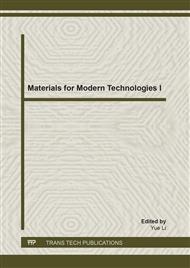[1]
Y. Picó, V. Andreu, Fluoroquinolones in soil-risks and challenges, Anal Bioanal Chem 387 (2007) 1287–1299.
DOI: 10.1007/s00216-006-0843-1
Google Scholar
[2]
E. Marti, B. Huerta, S. R. Mozaz, et al. Characterization of ciprofloxacin-resistant isolates from a wastewater treatment plant and its receiving river, water research. 61(2014) 67-76.
DOI: 10.1016/j.watres.2014.05.006
Google Scholar
[3]
X. Ye, J. Kuang, X. Li, G. Tang. Microstructure, properties and temperature evolution of electro-pulsing treated functionally graded Ti–6Al–4V alloy strip. Journal Of Alloys And Compounds. 599 (2014) 1-9.
DOI: 10.1016/j.jallcom.2014.02.055
Google Scholar
[4]
X. Ye, G. Tang, G. Song, J. Kuang. Effect of electropulsing treatment on the microstructure, texture, and mechanical properties of cold-rolled Ti–6Al–4V alloy. Journal Of Materials Research. 29 (2014) 1500-12.
DOI: 10.1557/jmr.2014.171
Google Scholar
[5]
X. Ye, X. Li, G. Song, G. Tang. Effect of recovering damage and improving microstructure in the titanium alloy strip under high-energy electropulses. Journal Of Alloys And Compounds. 616 (2014) 173-83.
DOI: 10.1016/j.jallcom.2014.07.143
Google Scholar
[6]
X. Ye, Y. Ye, G. Tang. Effect of electropulsing treatment and ultrasonic striking treatment on the mechanical properties and microstructure of biomedical ti-6Al-4V alloy. Journal of the Mechanical Behavior of Biomedical Materials. 40 (2014).
DOI: 10.1016/j.jmbbm.2014.08.022
Google Scholar
[7]
S. Tewari, R. Jindal, Y. Kho, E. Choi, Major pharmaceutical residues in wastewater treatment plants and receiving waters in Bangkok. Thailand, and associated ecological risks, Chemosphere, 91 (2013) 696–704.
DOI: 10.1016/j.chemosphere.2012.12.042
Google Scholar
[8]
M. Mahdi-Ahmed, S. Chiron, Ciprofloxacin oxidation by UV-C activated peroxymonosulfate in wastewater, Journal of Hazardous Materials 265 (2014) 41– 46.
DOI: 10.1016/j.jhazmat.2013.11.034
Google Scholar
[9]
C. Liu, V. Nanaboina, G. Korshin, W. Jiang, Spectroscopic study of degradation products of ciprofloxacin, norfloxacin and lomefloxacin formed in ozonated wastewater, Water Res. 46 (2012) 5235 – 5246.
DOI: 10.1016/j.watres.2012.07.005
Google Scholar
[10]
K. Li, P. Zhang, L. K. Ge, et al, Concentration-dependent photodegradation kinetics and hydroxyl-radical oxidation of phenicol antibiotics, Chemosphere 111(2014) 278-282.
DOI: 10.1016/j.chemosphere.2014.04.052
Google Scholar
[11]
M. Ahmad, Y. K. Joo, s. s. Lee, et al, Inhibitory effect of veterinary antibiotics on denitrification in groundwater: A microcosm approach, The Scientific World Journal 2014(2014) Article ID 879831, 7 pages.
DOI: 10.1155/2014/879831
Google Scholar
[12]
X. Xu, Y. Gao, J. Luo, et al, Interaction of veterinary antibiotic tetracyclines and copper on their fates in water and water hyacinth (Eichhornia crassipes), Journal of Hazardous Materials 280 (2014) 389– 398.
DOI: 10.1016/j.jhazmat.2014.08.022
Google Scholar
[13]
S. Subhadrabandhu, S. Ketsa , T. Daphne, et al. Durian, king of tropical fruit, New Zealand, (2001).
DOI: 10.1079/9780851994963.0000
Google Scholar
[14]
M.A. Mohammed, A. Shitu, M. A. Tadda, et al, Utilization of various Agricultural waste materials in the treatment of Industrial wastewater containing Heavy metals: A Review, Int. Res. J. Environment Sci. 3 (2014) 62-71.
Google Scholar
[15]
D. Sud, G. Mahajan, M.P. Kaur, Agricultural waste material as potential adsorbent for sequestering heavy metal ions from aqueous solutions—a review, Bioresour. Technol. 99 (2008) 6017–6027.
DOI: 10.1016/j.biortech.2007.11.064
Google Scholar
[16]
B. H. Hameed, H. Hakimi. Utilization of durian (Durio zibethinus Murray) peel as low cost sorbent for the removal of acid dye from aqueous, Biochemical Engineering Journal, 38(2008) 338-343.
DOI: 10.1016/j.bej.2007.10.005
Google Scholar


